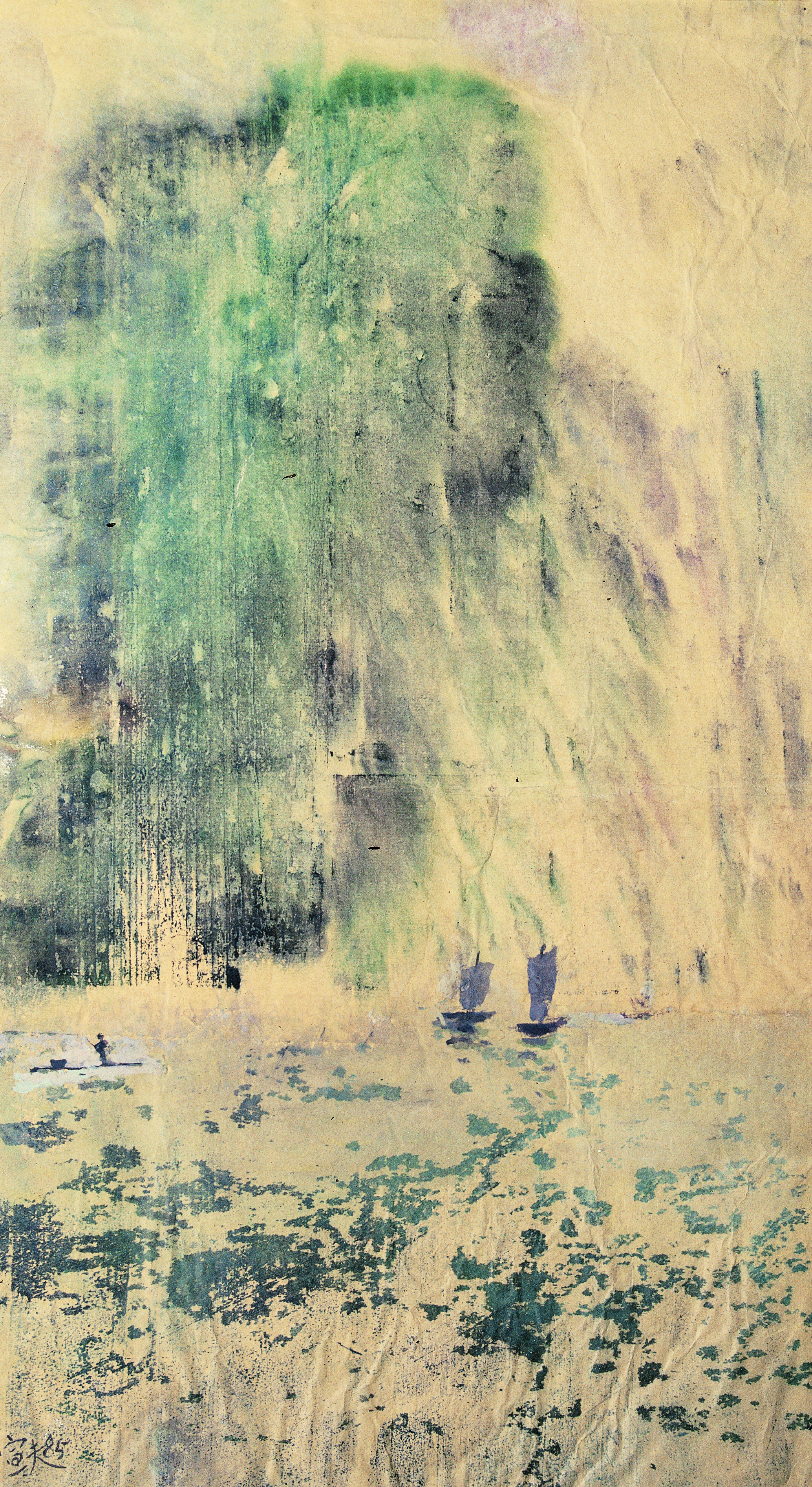The Third Period 1976~1998
After the Cultural Revolution comes the third stage of Mr. Qin’s art creation. At this stage, the rapid progress and prosperity of the society and the stability of life stimulated Mr. Qin’s enthusiasm. He wanted to get back the time wasted during the Cultural Revolution, and, in the spare time, he created many paintings.
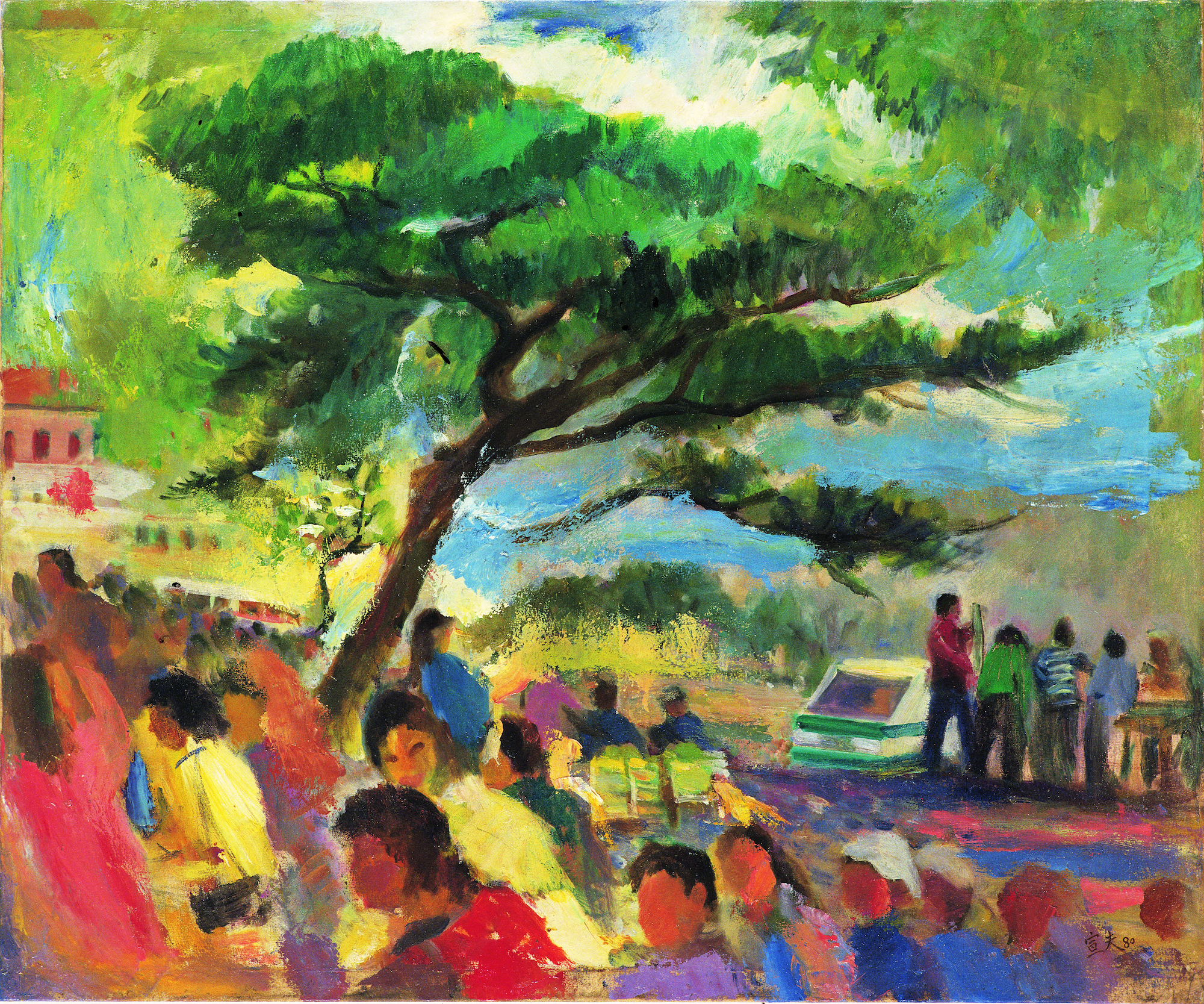
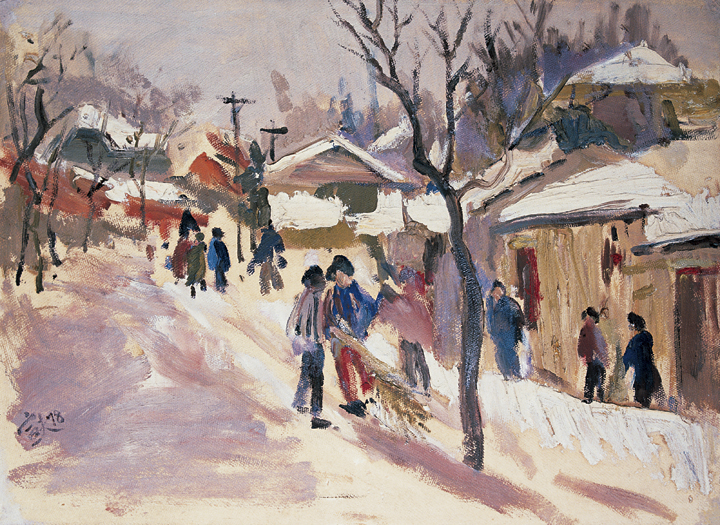
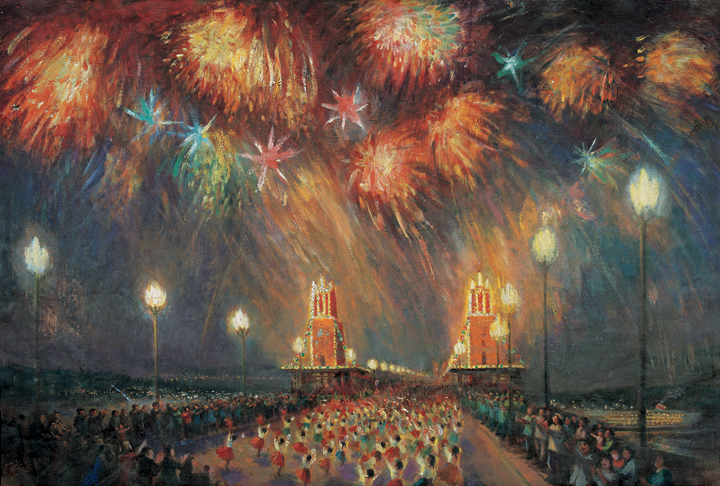
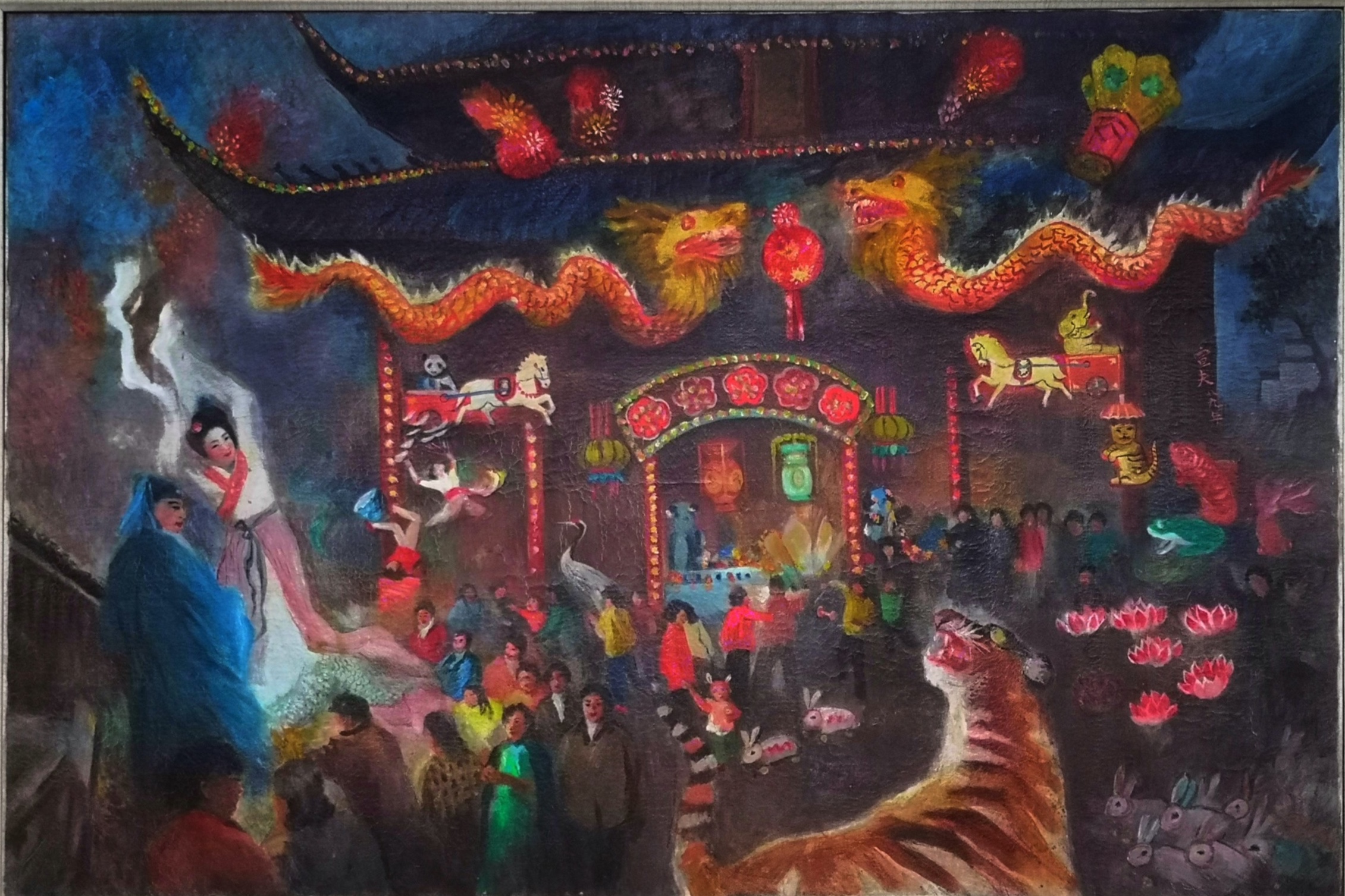
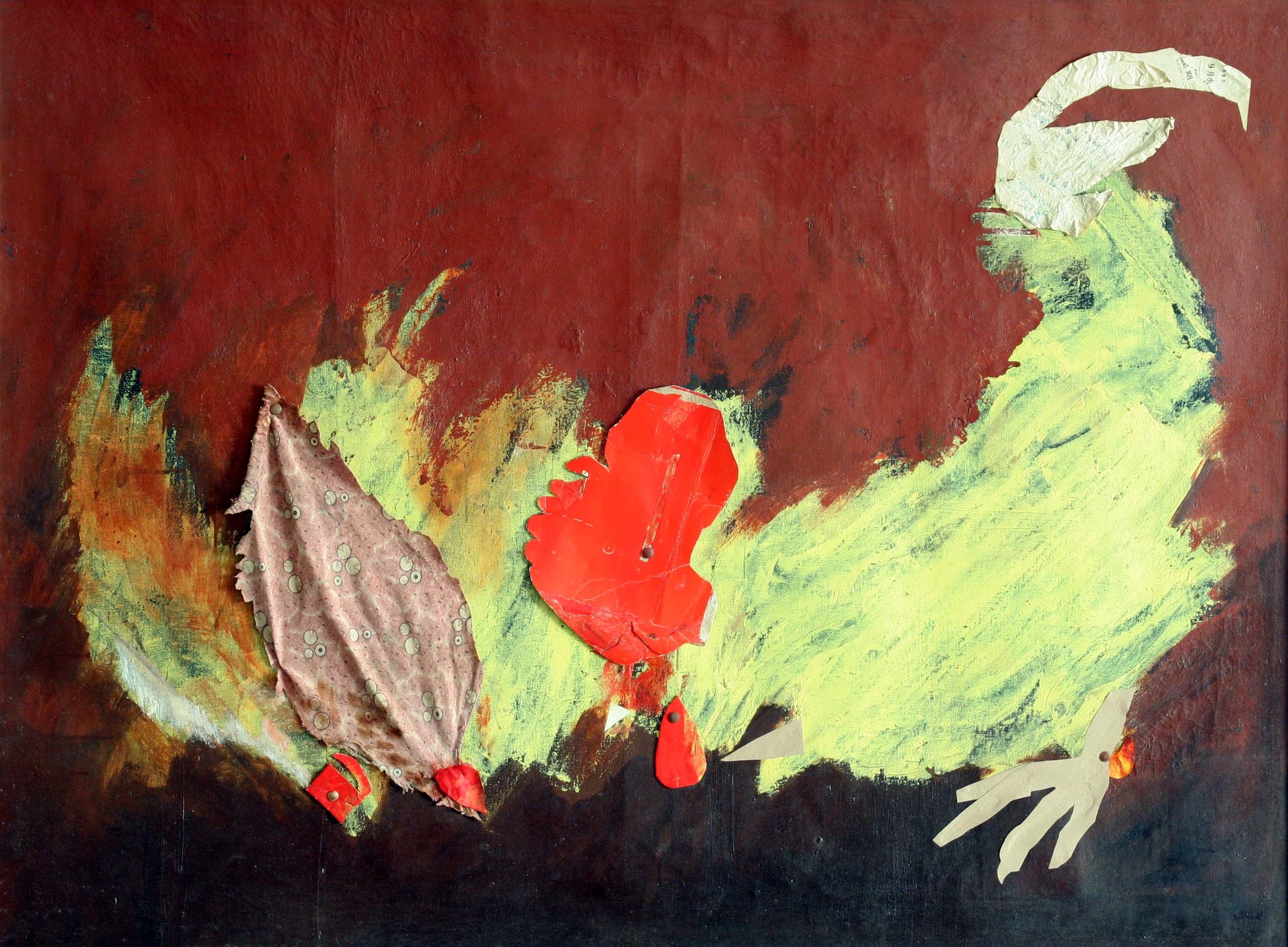
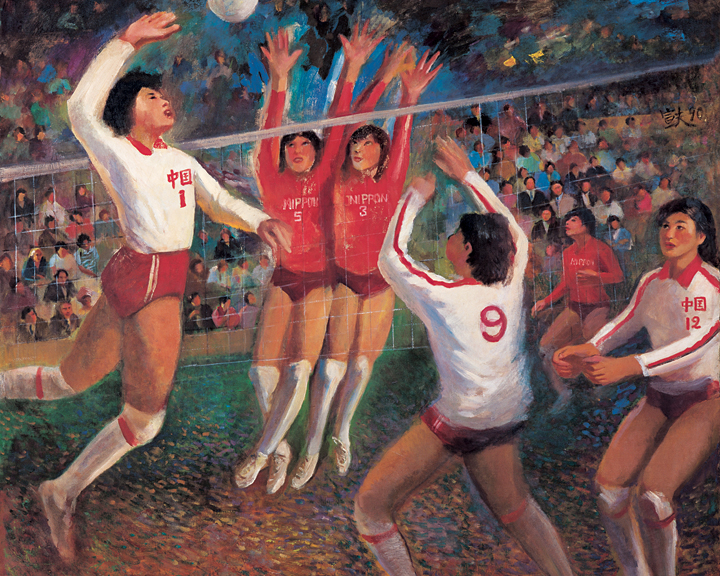
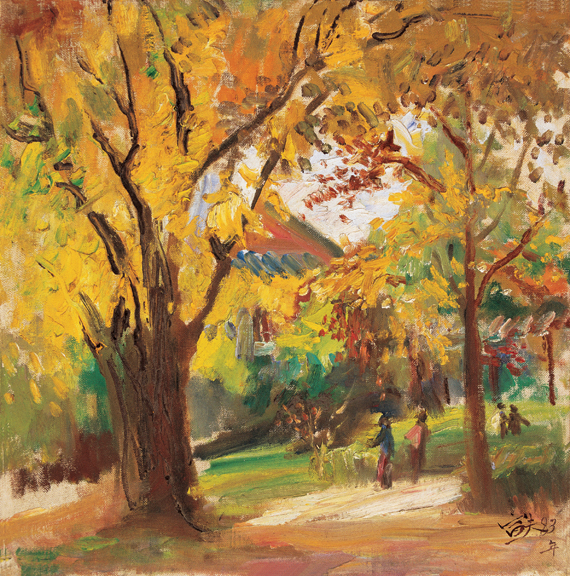
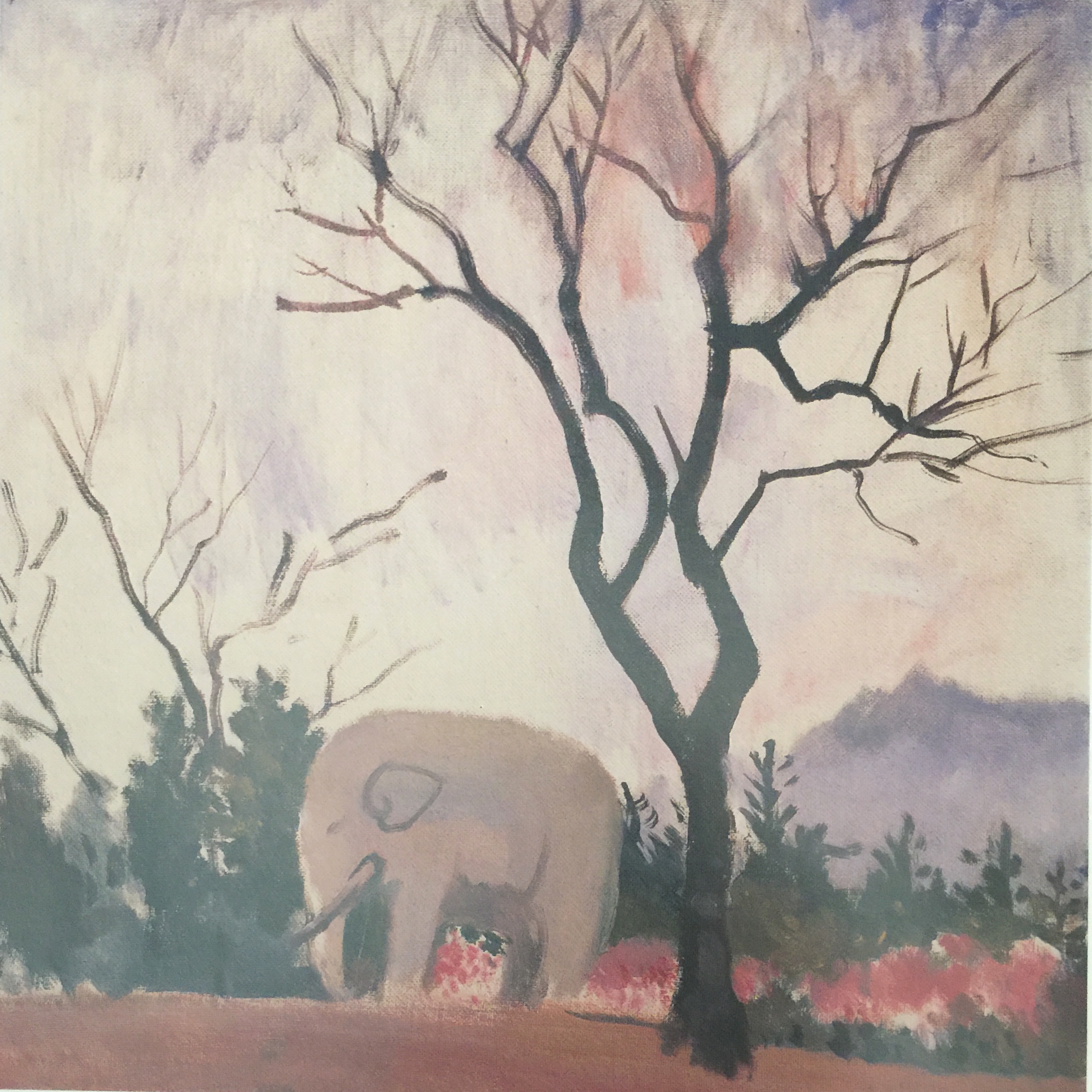
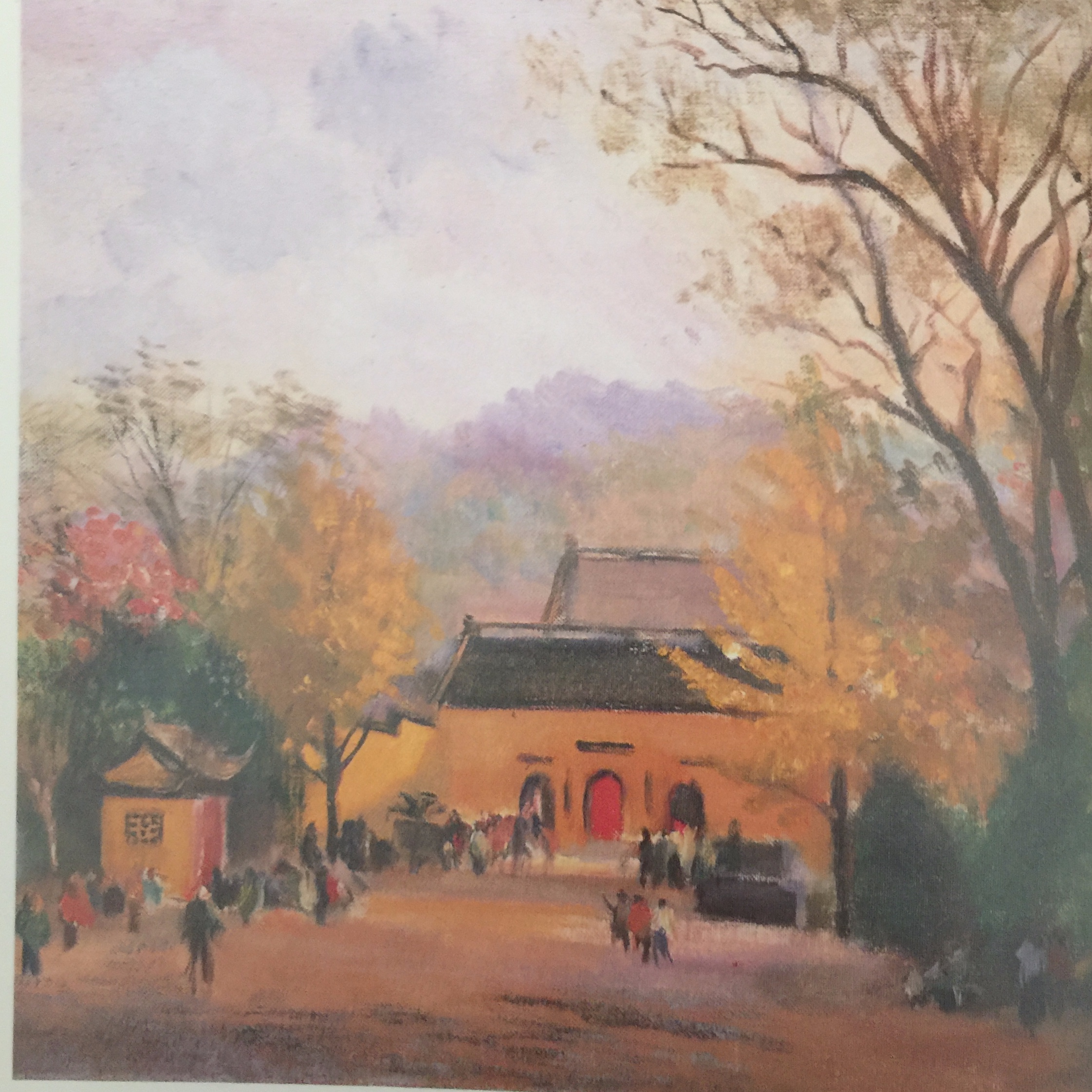

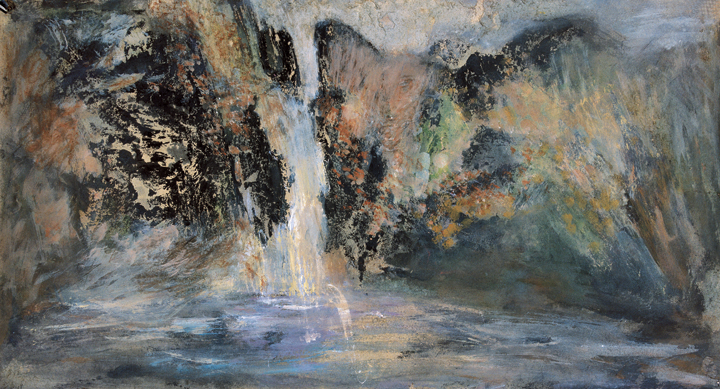
Oil Painting
The oil painting “Fireworks on the Yangtse River Bridge” is rich in colors, bright with lights and a magnificent landscape. In it, he did not make detailed sketches of characters but focused on the visual effects of lights and colors and the sharp contrast between lights and shadows. The painting well represented the joyful atmosphere of a holiday night, both physically and spiritually.(The oil painting “Fireworks on the Yangtse River Bridge”)
The same is true for another large size oil painting “The Lantern Festival at the Confucius Temple”, which depicts a festival night. In the painting, the author applied a different and unconstrained style. He paintswhere his interests and feelings are with humor romance, with frankness and with true feelings. (The oil painting “The Lantern Festival at the Confucius Temple”, the oil painting with pasted texile “The big Roaster”)
The theme of the large oil painting “Battling” is the praise the spirit of Chinese Women’s volleyball players,but he focused on the subtle art of lights and colors and presented the battling atmosphere effectively. (The oil painting “Battling”)
In his paintings “Late Fall” and “Ginkgo”, we can see a bright and colorful world; it is simply a symphony of lights and colors!
Mr. Qin’s last oil painting is “Imaged Structure” painted at the age of 85 . It is a painting with free, daring imagination. In the painting, there are magnificent mountains and falls with water swiftly coming down from the mountain, splitting high waves in the little pond. With the magnificent atmosphere and hazy, but energetic features, the painting is just like a traditional Chinese heavy ink painting. (The oil painting “Imaged Structure”)
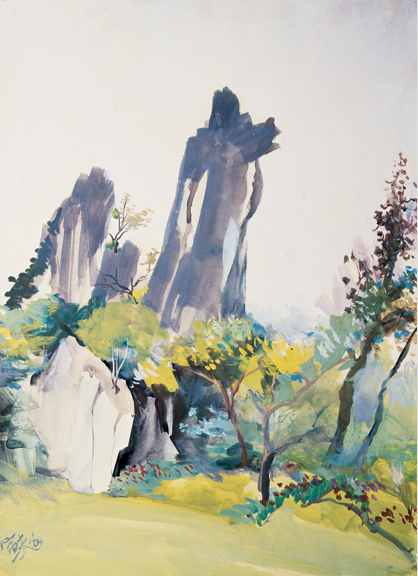
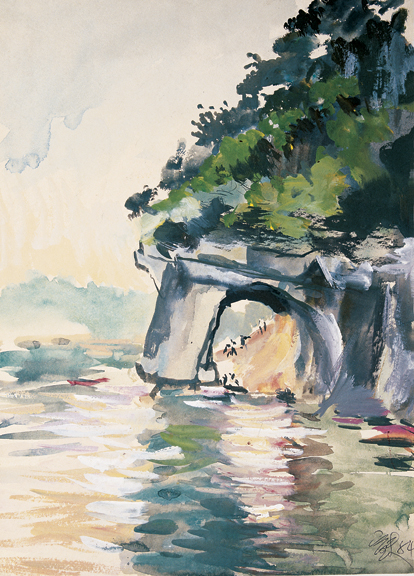
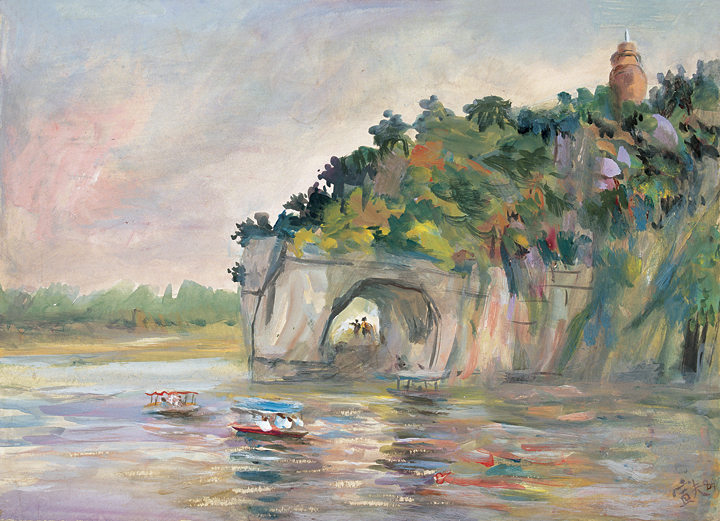

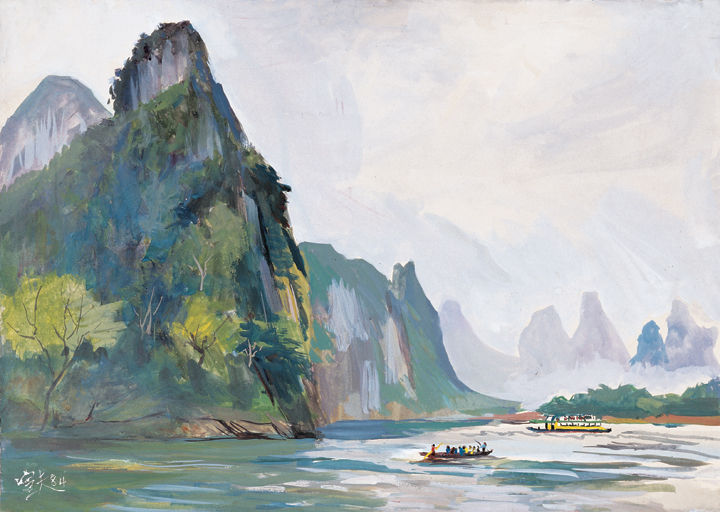
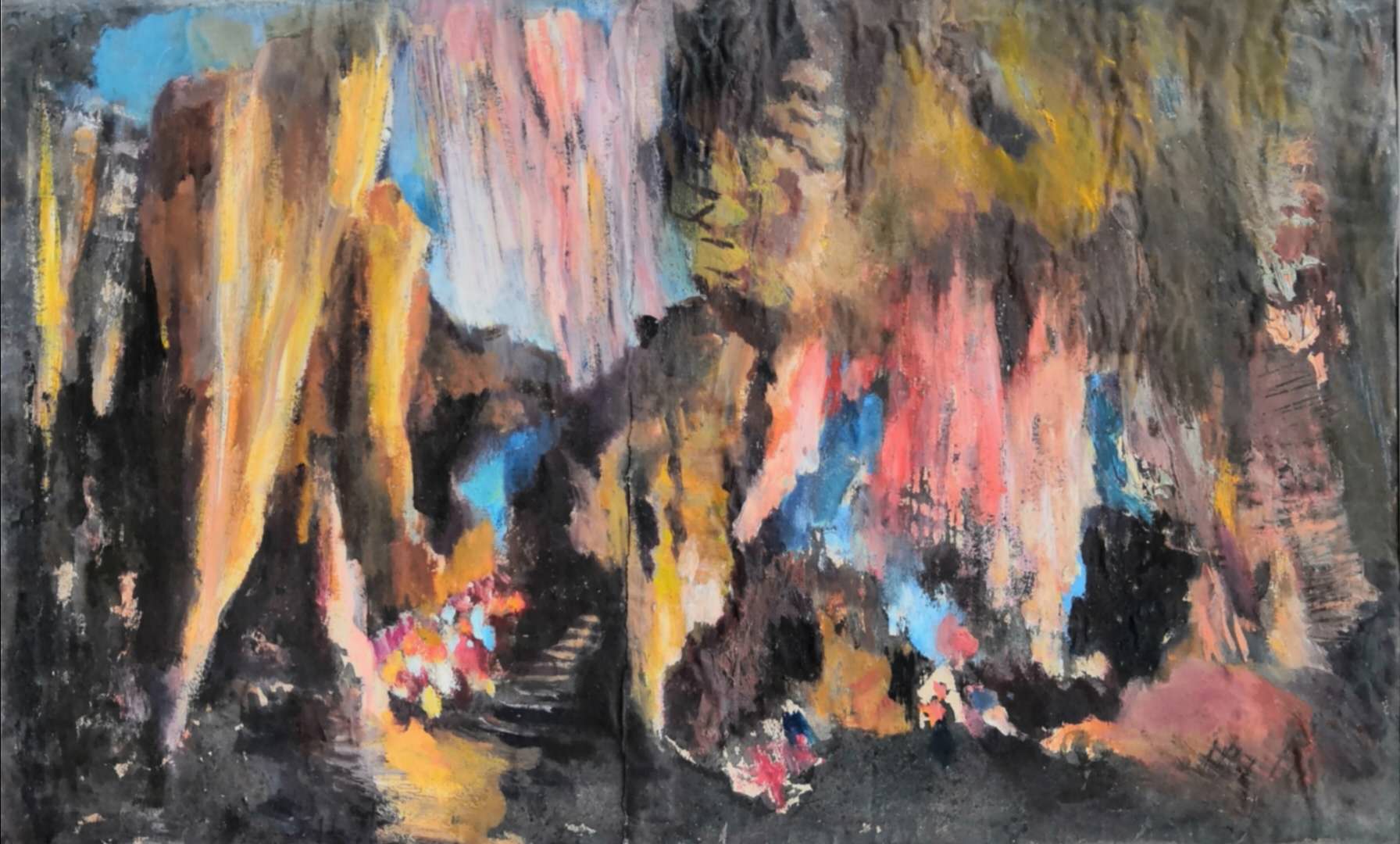
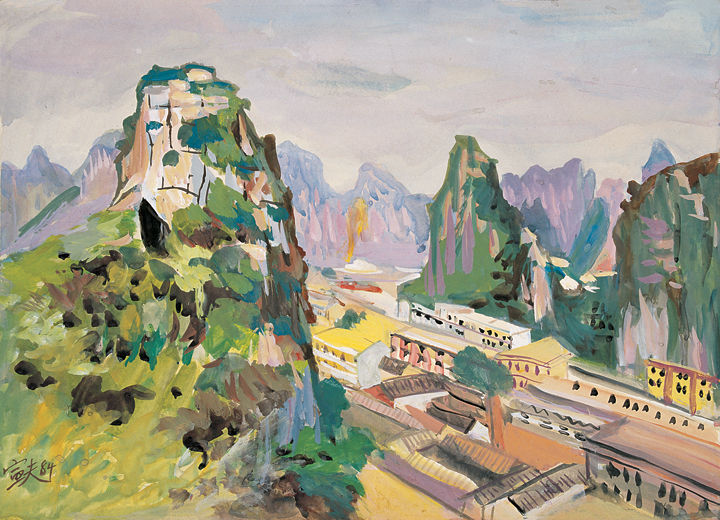
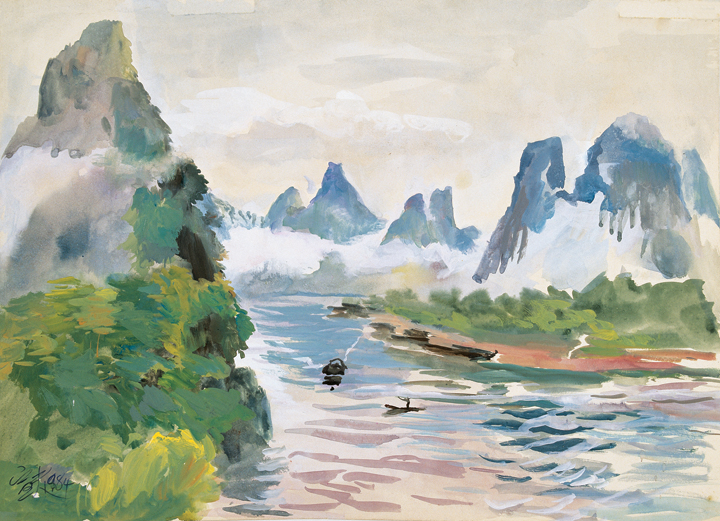

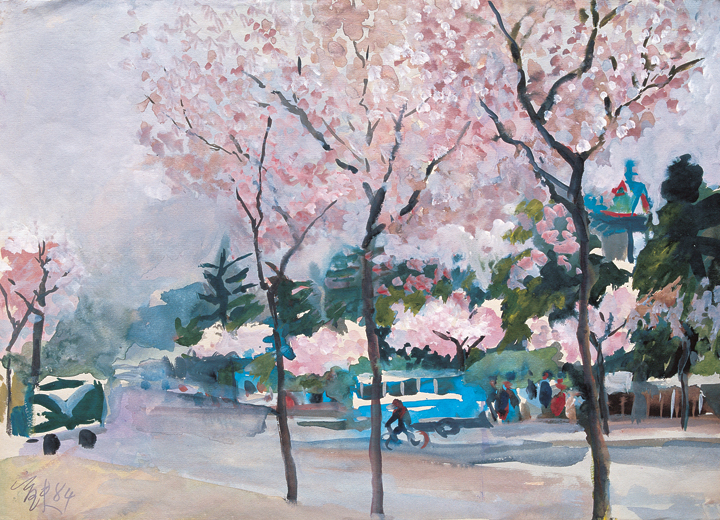
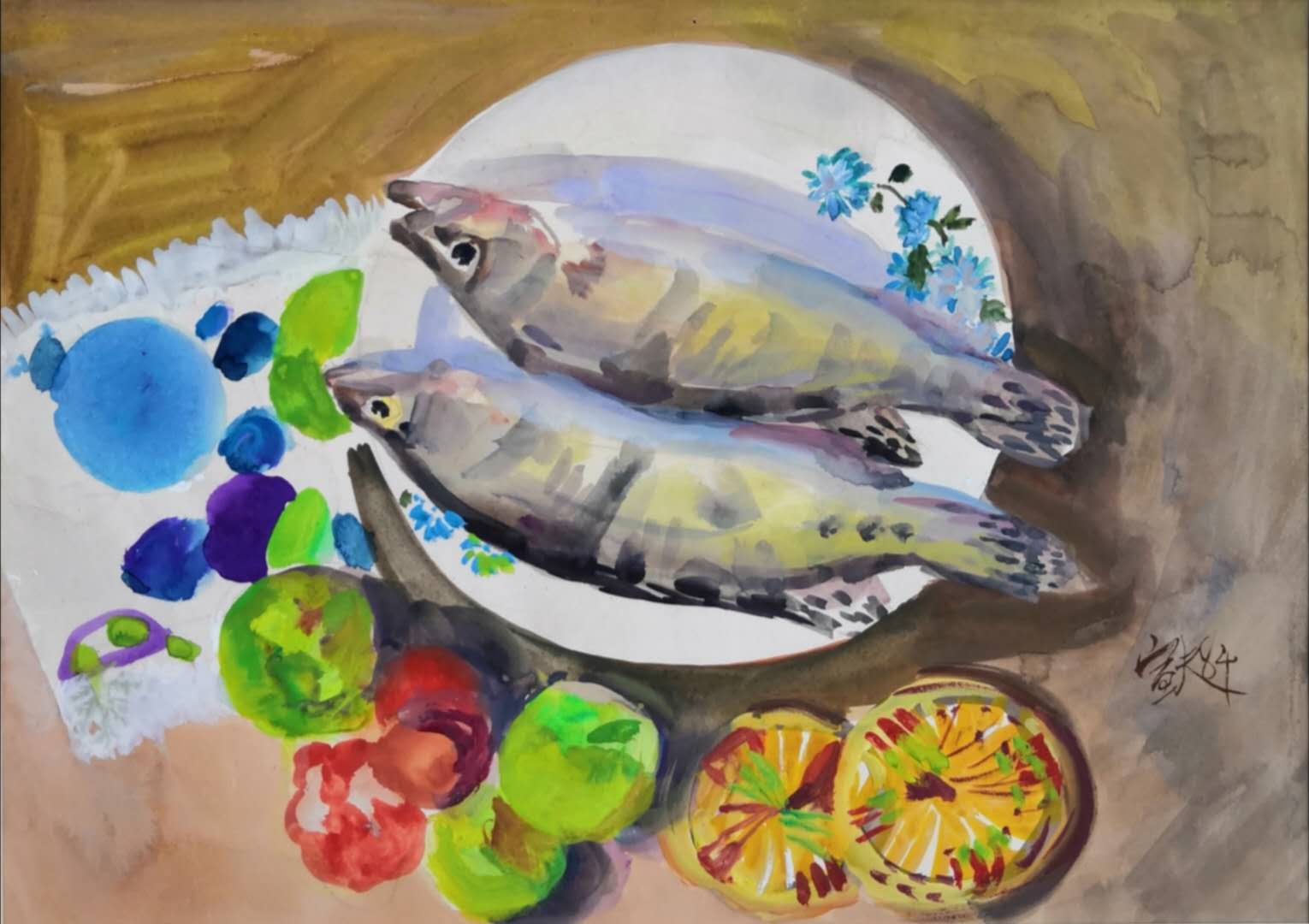
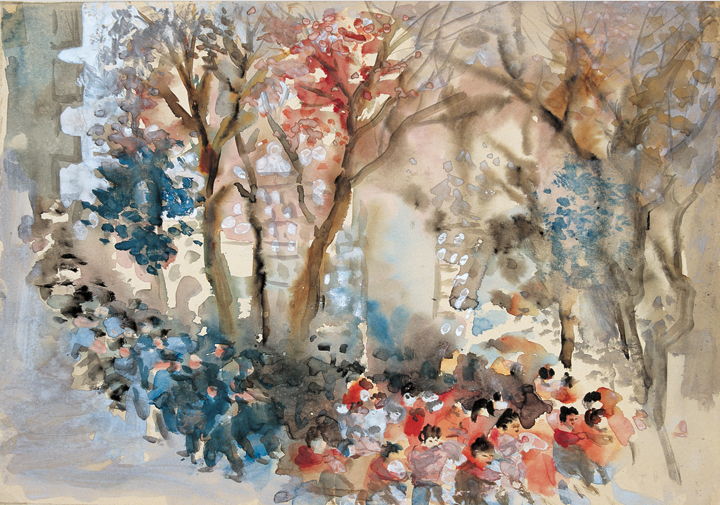
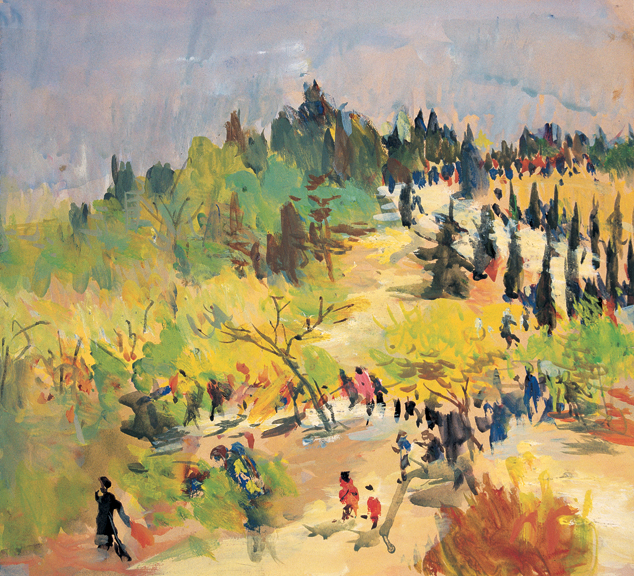
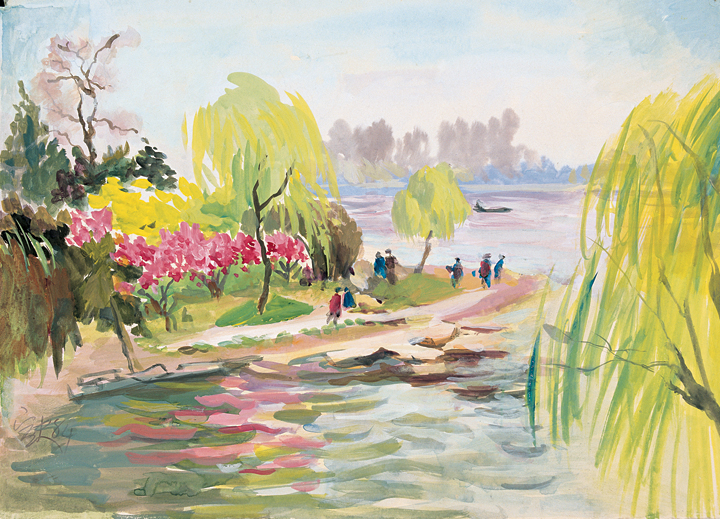

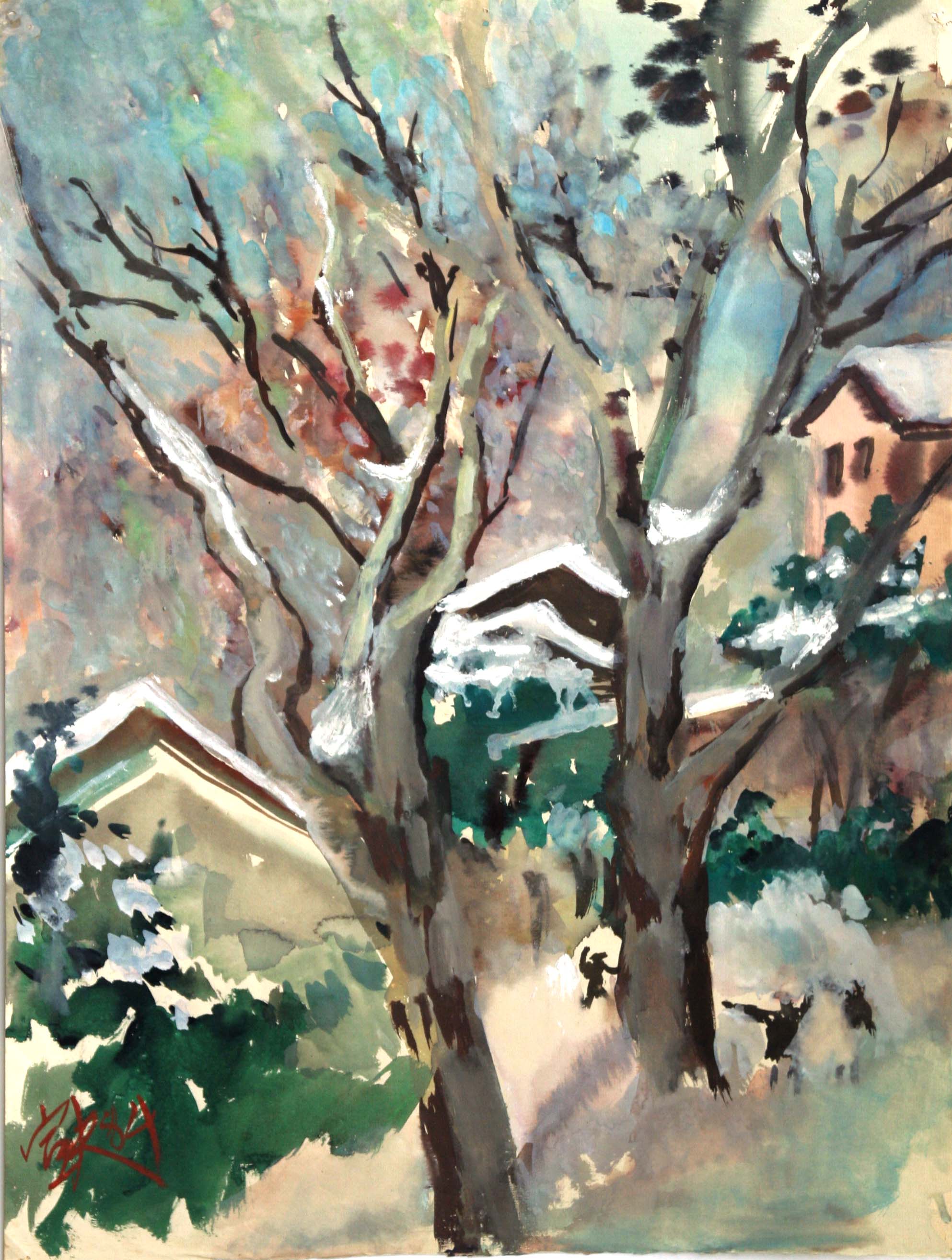
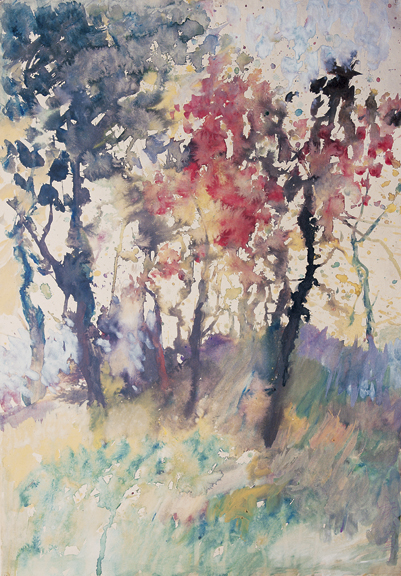
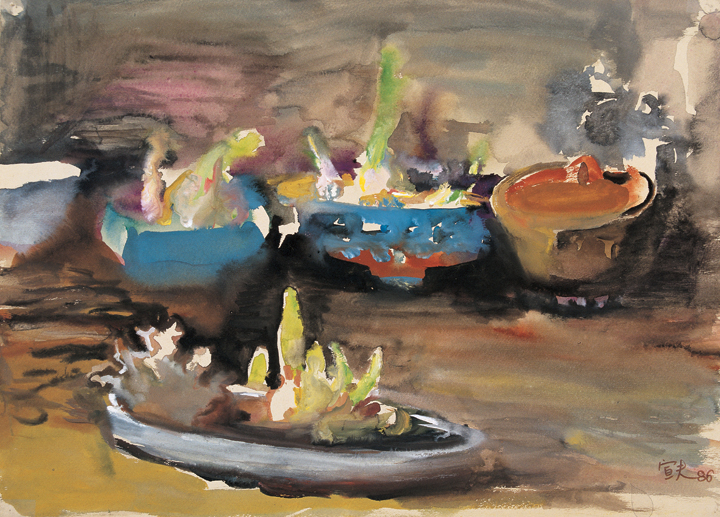
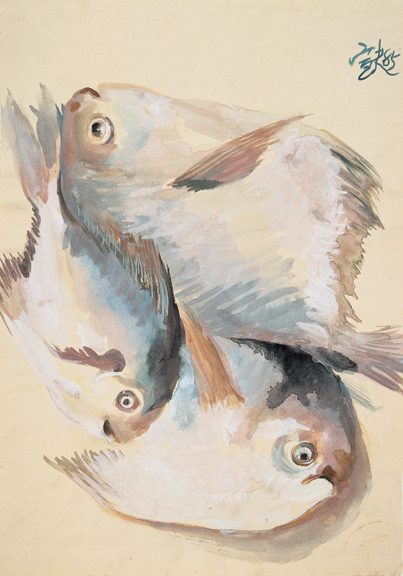
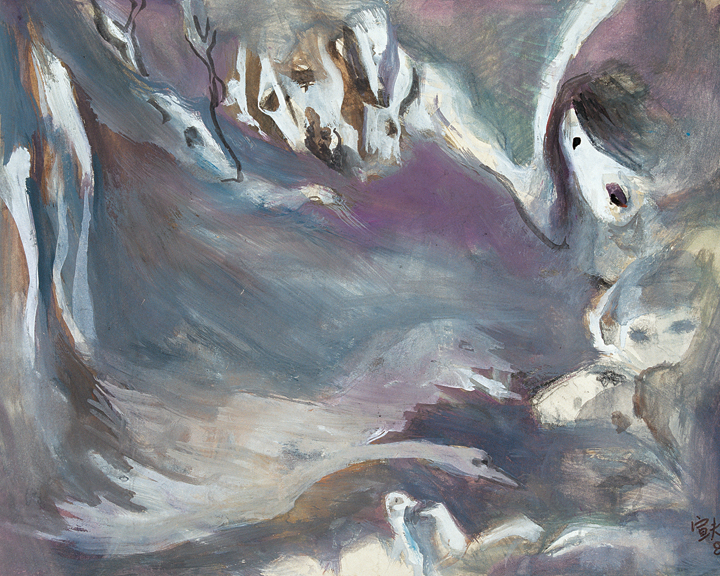
The water color/gouache
In 1984, Mr. Qin went to Guilin to practice. He only painted two oil paintings, the rest are all powder color paintings. He once pointed out to family that his powder color paintings and oil paintings are equally good .
The painting “Guilin Camel Mountain” takes the mountain as its theme. He author was not restricted to the detailed depicting of mountains and rocks, but focused on expressing his feelings and spirit. With unconstrained strokes, one can feel that he completed the whole painting in one breath.
(The gouache “Guilin Camel Mountain”)
The painting “The Elephant Trunk Mountain” has the style of the artistic masters; strokes are bold, unconstrained and vigorous.
(The gouache “The Elephant Trunk Mount in Guilin-1”)
Another painting “Elephant Trunk Mountain in Gulin” has the same theme, but is quite a different styles; with detailed strokes and bright colors, especially the beautiful colors of the river, creating different levels, and making the scenery very lively.
(The gouache “The Elephant Trunk Mount in Guilin-2”)
There are many other water color/gouache paintings with a similar style, such as ”Xingpin LiJiang River Ferry in the Morning” and “Guilin Old Man Mountain” using bright colors and detailed levels, “Xingpin2” and “Smoky and Rainy Lijiang River”, and “ Big Maple Tree,” with mist, cloudy mountains and lively water colors.
(The water color “Yingjiang Pavilion in Yangshuo”, the water color “Xingpin LiJiang River Ferry in the Morning” , the water color ““Xingpin2”, the water color “, the water color “Smoky and Rainy Lijiang River”, the water color ““Guilin Old Man Mountain”)
Other water color and gouache paintings in the same year included “Cheri Blossom”, continuing a strong poetic theme of blooming in spring; ”Morning Exercises” reflecting dim but lively morning lights; “The Spring in YuhuaTai” and “Spring in Xuanwu Lake”, emphasizing colorful blooming flowers; calm and elegant “Snow in the Front Yard”, “Pine Tree”; fresh and soft lighted “Narcissus “, and ”Sword Fish”.
In “The Swan’s Death”, the author emphasized its tragic atmosphere in hazy cold colors. Depicting a half realistic and half abstract white swan and a wicked bird, the painting is full of tragic atmosphere.
Monotype
In his late years, Mr. Qin created a lot of monotype paintings. In the nineteen eighties, due to Mr. Qin’s age, it became hard for him to carry a painting case and go out to paint. He began to paint at home. He wanted to express in his paintings. The strong feelings about life that had been calculated in his heart for decades and decades-- his pursuit for truth, righteousness and perfection. He also attempted to experiment in his paintings with various materials, colors and skills. His paintings during this time have various themes, such as realistic, abstract, mysterious, and imaginative, which fully demonstrated his profound cultural tastes and talents in art creation.
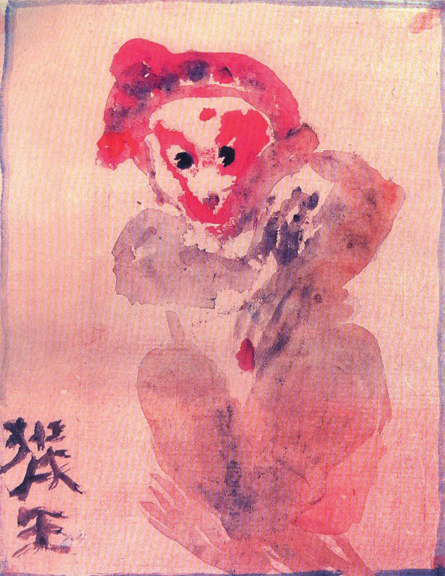

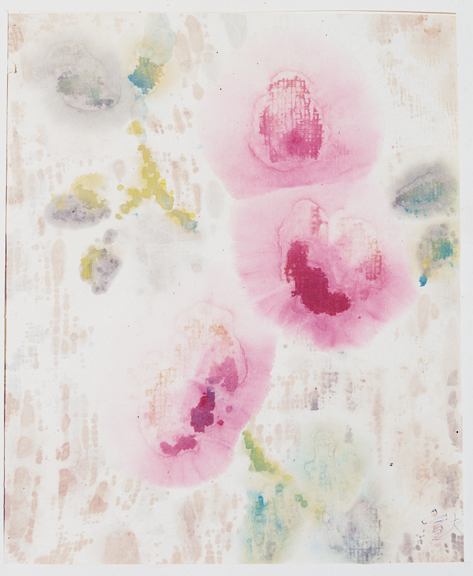

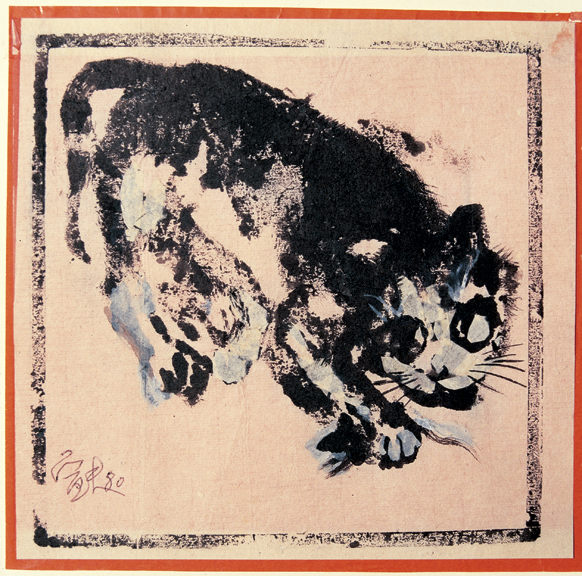
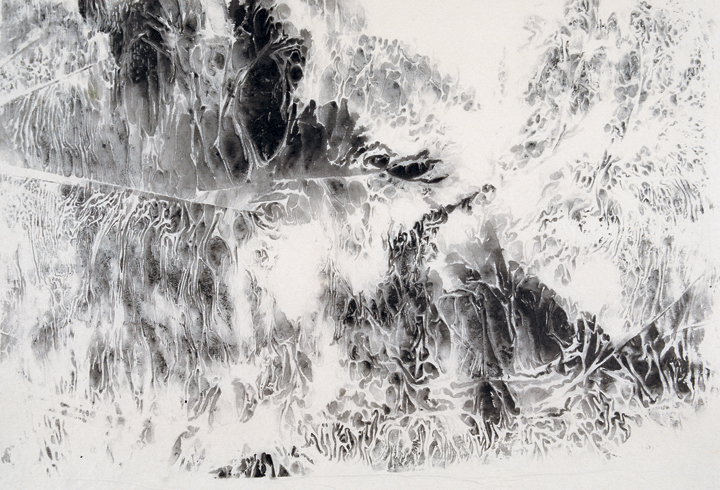
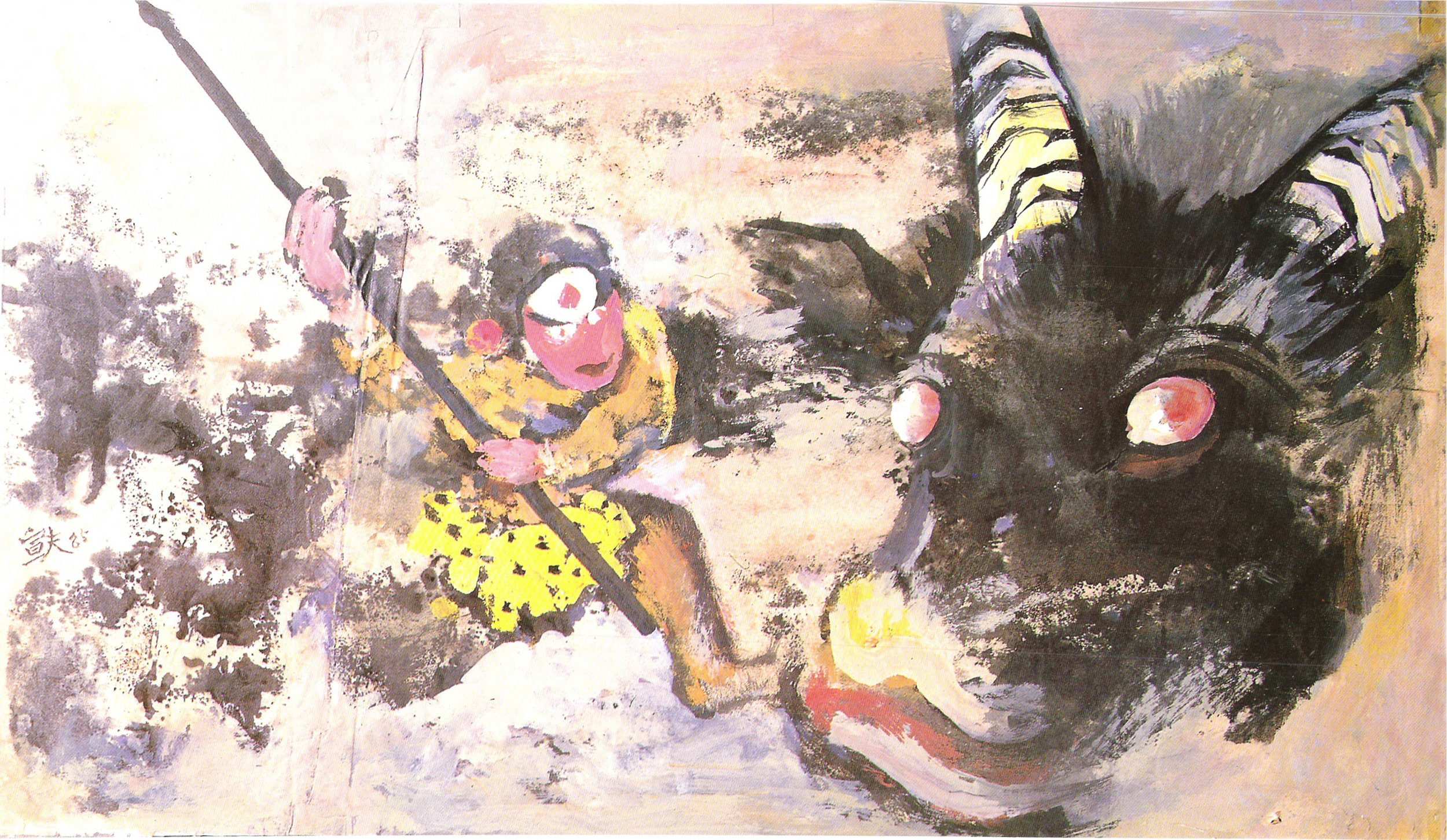
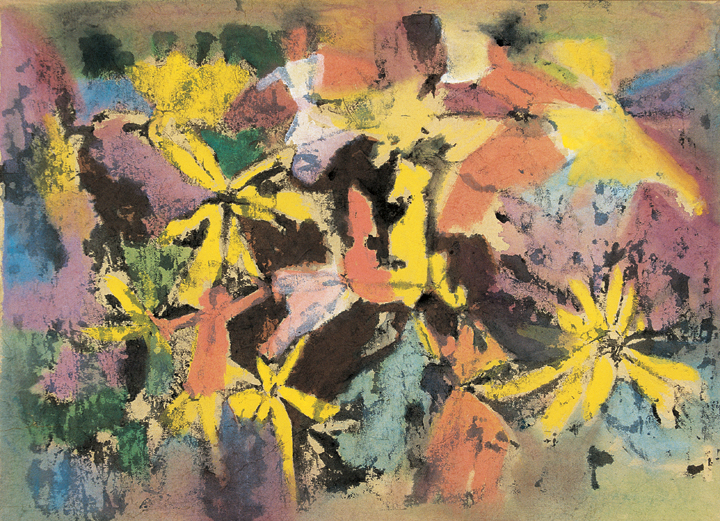
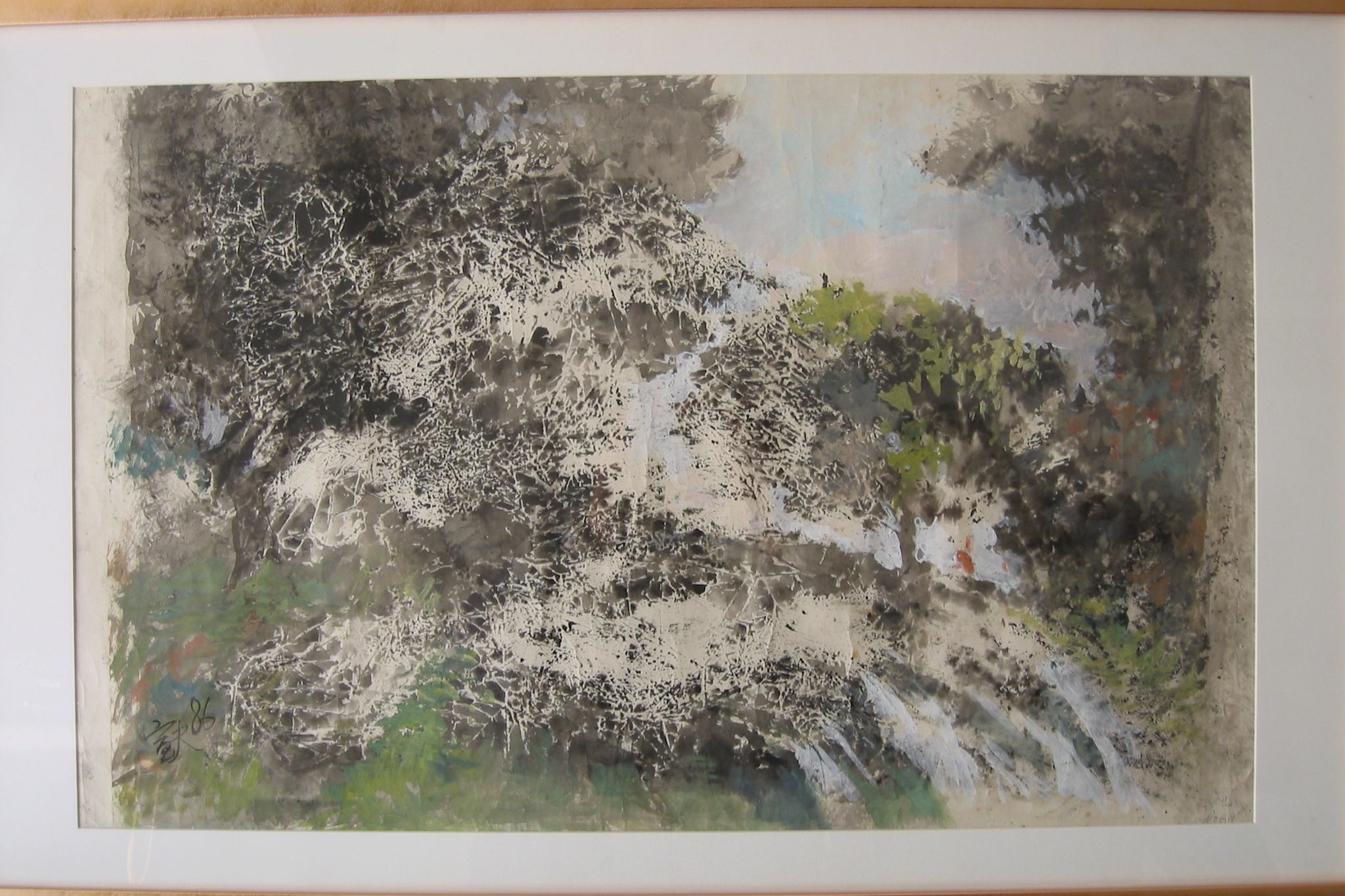
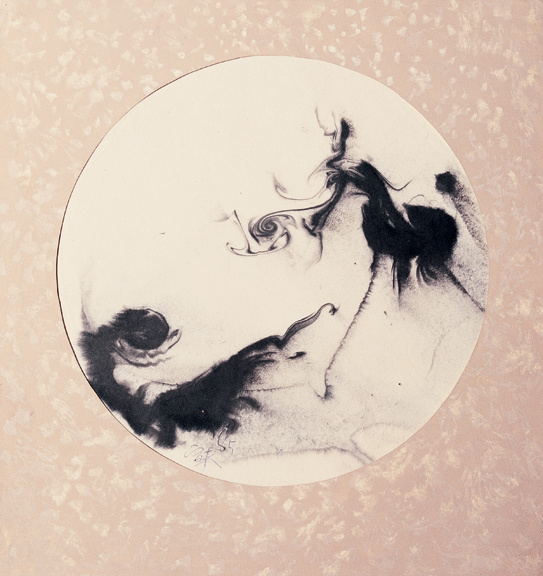
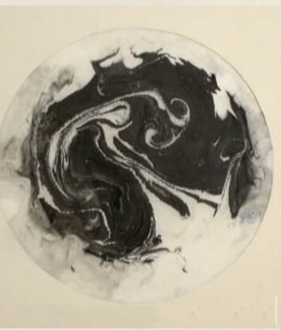
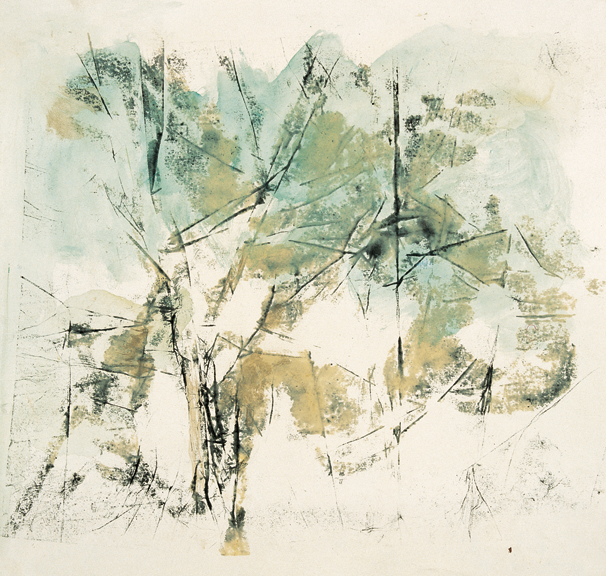
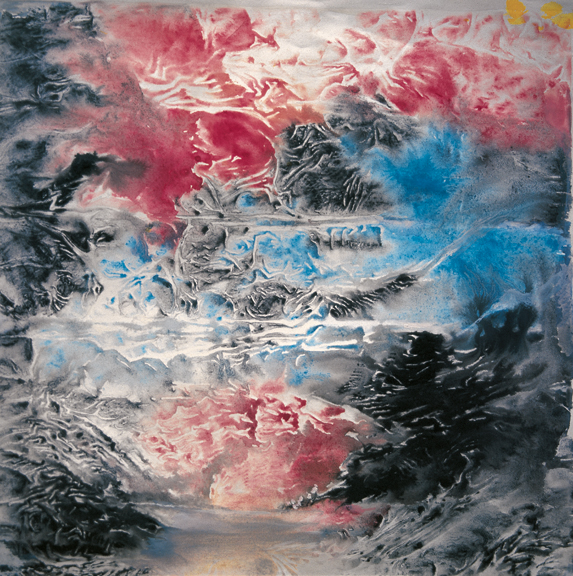

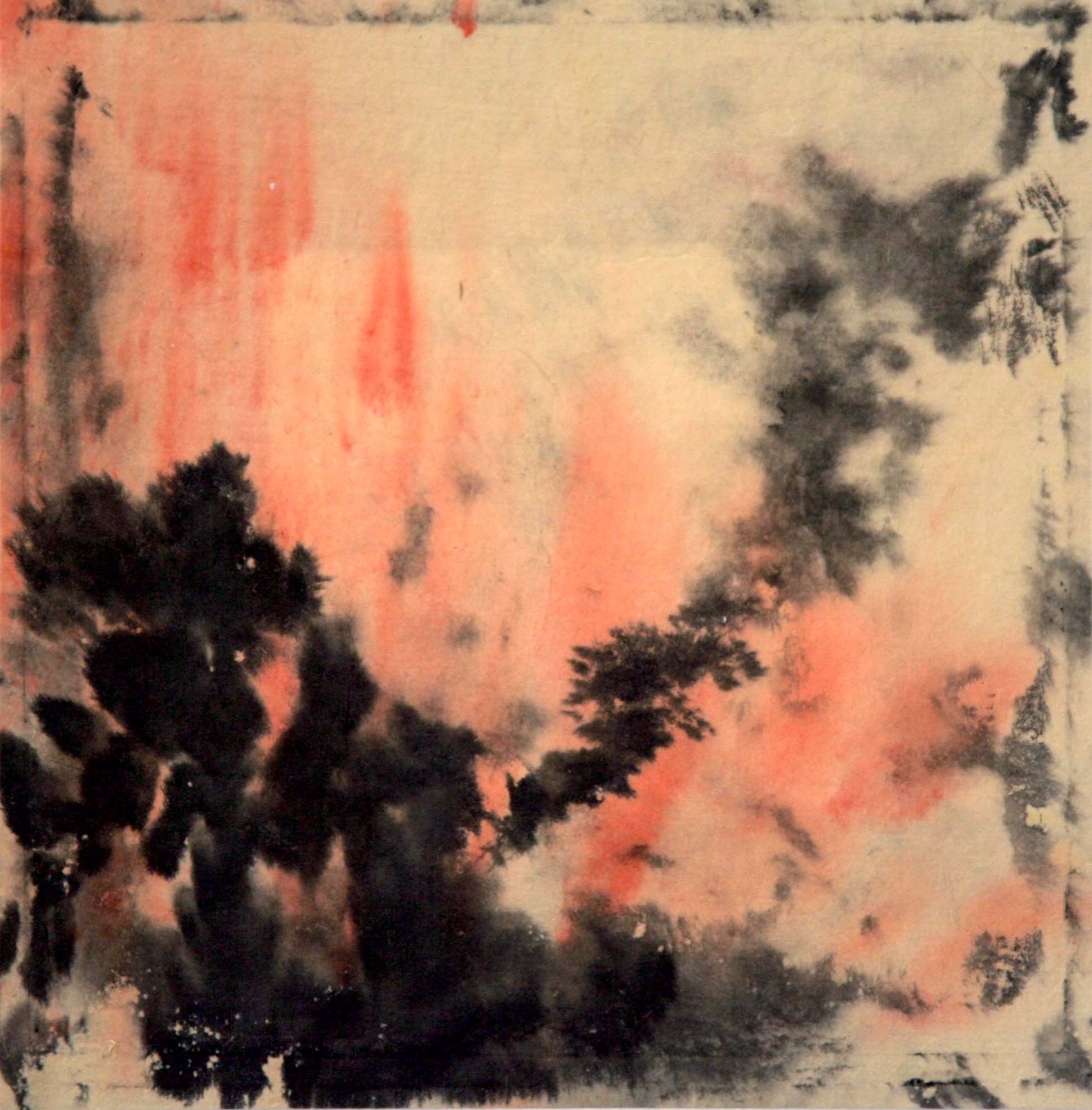
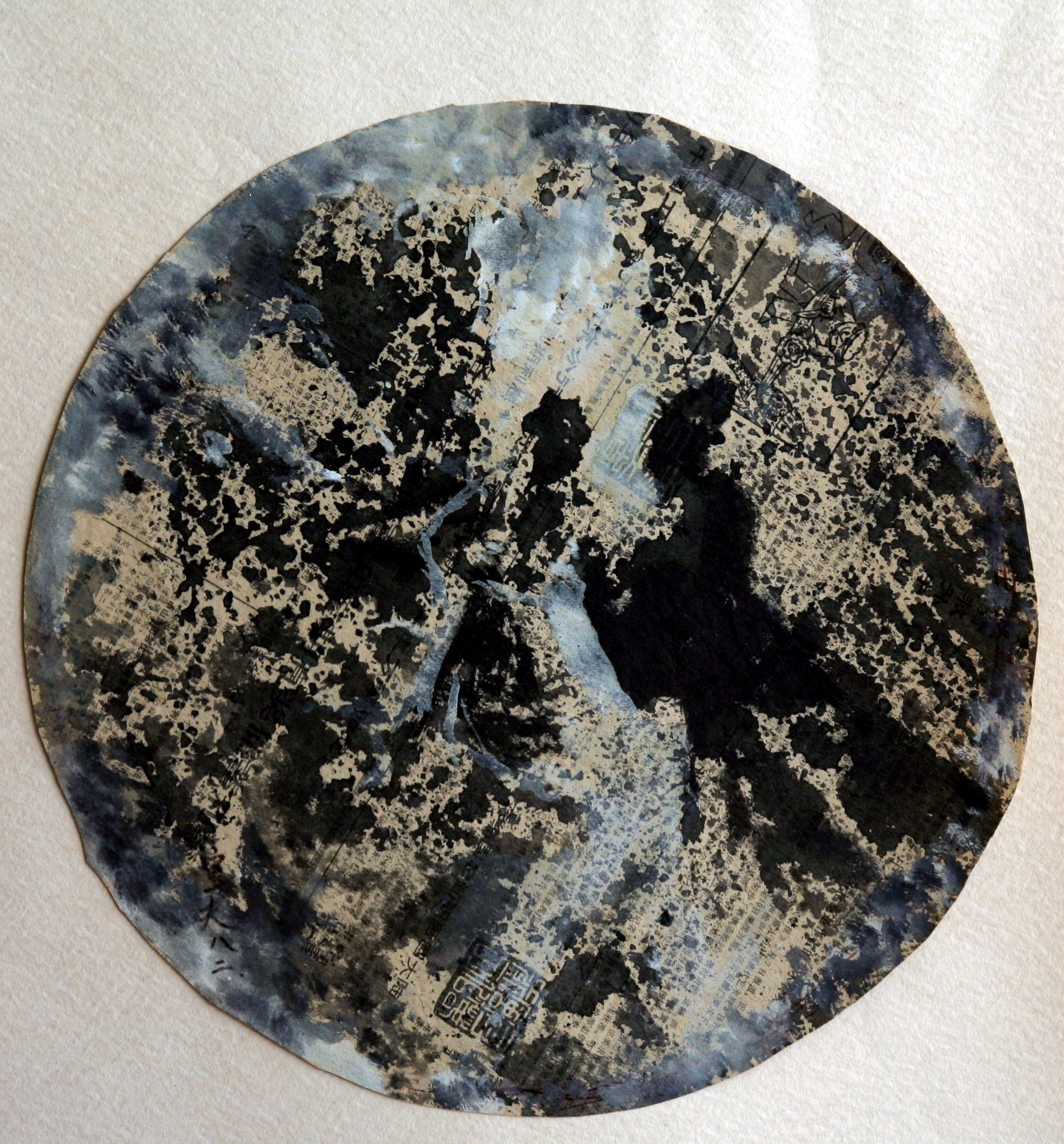
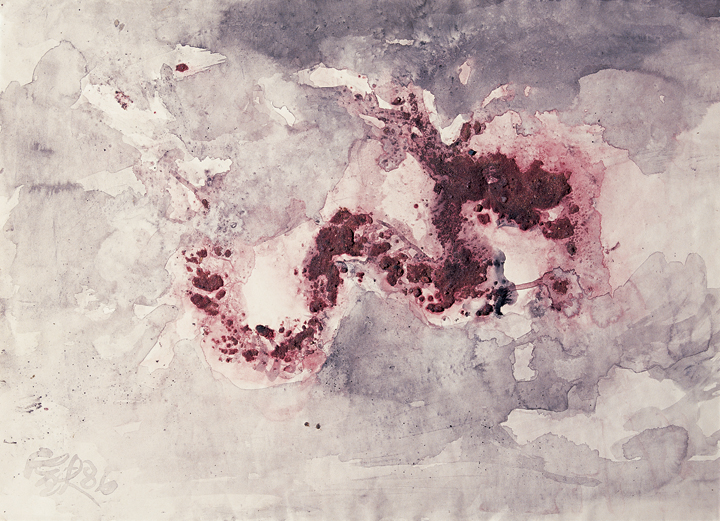
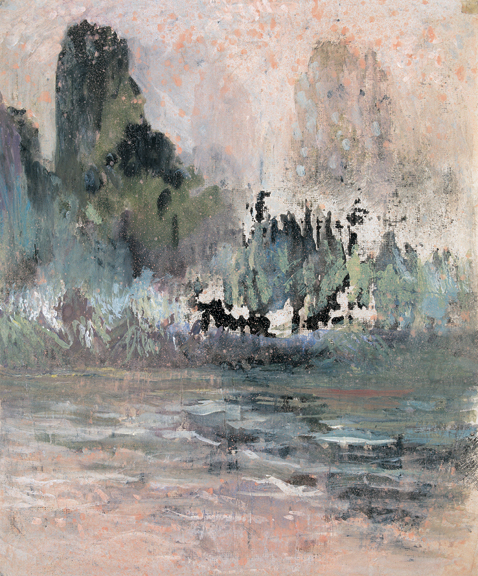
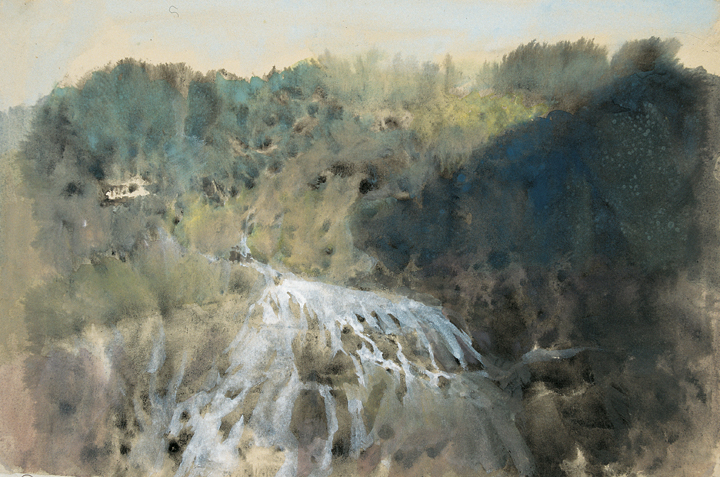
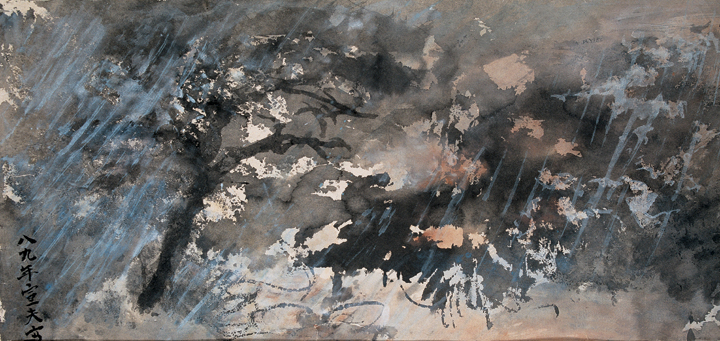
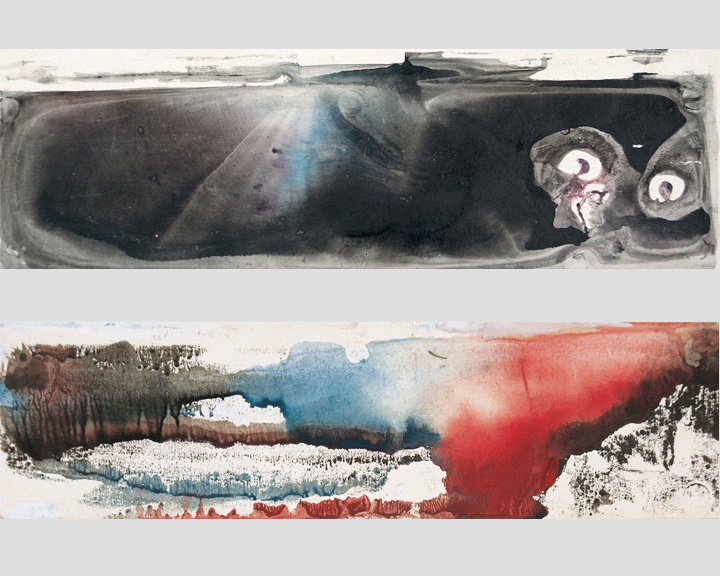
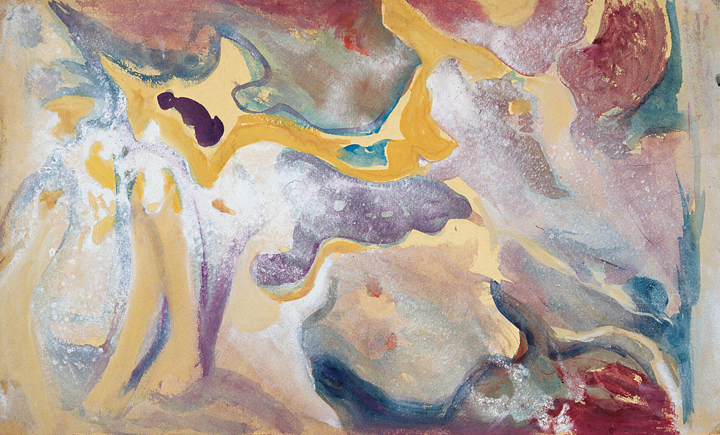
“Tiger in House” is a monotype painting. The water prints cause one to feel the hairiness of the cat, so as to empathize with the spirit of the cat, what a lively little tiger at home.(Monotype “Tiger in House”)
The painting “Black Cats, White Cats, Only Good Ones Can Catch Mice” captured the instant moment of a black cat catching a rat. The cat with two big alert eyes, was crawling toward the rat The rich and various ink colors, just like dry paintings in traditional Chinese fine art, are very effective in presenting the character.
The paintings “Dragons and Phoenix” and “Golden Fish” have a stronger delicate, Chinese flavor; the modeling of dragon, phoenix and golden fish is quite unique and full of originality. (The monotype “Dragons and Phoenix” , the monotype “Golden Fish” )
He also created some colorful monotype paintings, such as “Flower” and “Scenery”. The paintings are fresh and rich in colors that are well blended with moisture. Some colors are light and elegant, some are strong and bold, and some are bright and beautiful.
The painting “Handsome Monkey King” and “The Monkey King fought with Ox Devil” depicted a cute, sprightly, humorous and lovely monkey king, as well as a brave fighter.
Some monotype paintings are very abstract and are focused on expressing his feelings and spirit.
(Monotype “The justice and Evil”, “Fight”)
His painting “Dragon with Reddish Mustaches” gives us a picture of a vigorous dragon that is mounting the clouds and riding the mist. The background, fogs and clouds was made of water prints scattered with sands dyed in colors. This is a breakthrough in modeling.
The painting “Li Jiang In Mind” is a painting with free style and imagination. He used light green, grey and light powder as the background, and applied the traditional Chinese painting style of water prints using white powder to depict waves and space and then spreading light orange dots on the painting and to create an incredible poetic world
(The water color “Li Jiang in Mind”)
Some of his monotypes focused on visual effects of lights and colors, as in Dance”, “Two Dragons Play a Pearl”, and “Dragon Raises His Head”.
(The water color “Dance”, and “Dragon Raises His Head”.)
His monotypes, Mr. Shao Dazheng commented, “fully expressed his talent, his precious interests and innocence in childhood …. He painted with much ease at will, and was not restricted with any theoretic rules. He is able to intermingle some abstract factors in western arts with the free style in the Chinese tradition of arts… He is seeking playfulness in nature and freedom, or to be more exact, the natural flow of his feelings and emotions …
As for Mr. Qin’s third stage, Mr. Shao Dazheng commented,” His style is more straightforward, moving towards more freedom, and more feelings.” Another artist, Song Zhenying also commented, “He was no longer restricting himself to modeling and frames, but was more engaged in expressing his feelings. He painted where his feelings went and his paintings are full of life. The colors are bright and beautiful and the strokes are smooth and daring.”

